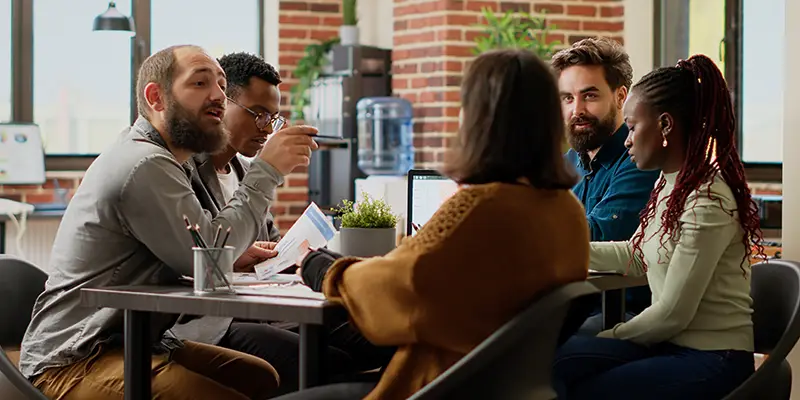Two brains are better than one, especially when considering team dynamics.
Research proves it. In fact, teamwork is 50% more efficient than working solo.
With the way we work evolving fast, teamwork isn’t just a soft skill. It’s a necessity. But here’s the catch: you can’t just put just anyone in the same boat and expect them to row in sync.
Teamwork must be developed — honed and sharpened — just like any other part of an organization.
Yet many organizations still don’t fully understand how their teams actually work together or why certain individuals behave the way they do. With 73% of companies planning to adopt collaborative tools by 2027, the need for stronger teamwork is only growing.
Wonderlic Team Dynamics is a new product extension immediately available in Wonderlic Develop, our employee development tool. Team Dynamics extends the value of Wonderlic Develop by highlighting how individuals collaborate and communicate best.
Some teams are completely new to improving their team dynamics, still figuring out how to communicate and collaborate. Others are already working on teamwork but want to refine and strengthen their approach. No matter where your team stands, success comes from understanding how people work together — and how to improve those interactions. In this article, we explore what makes teams thrive and how Wonderlic Team Dynamics can help at any stage of the journey.
Table of contents
What Is Team Dynamics?
Have you ever had a job where everyone in the team just clicks? Where ideas fly around effortlessly, and no one is scared to speak up?
Probably not — and that’s OK because great teamwork requires work. Some teammates thrive on brainstorming, while others struggle with decision-making. Some enjoy listening and are excited to share their two cents, while others happily nod along in meetings, too shy to speak up.
However, when individuals understand how to work together effectively, teamwork improves, better decisions are made, and engagement increases. When you consider that businesses with the highest levels of employee engagement have 21% more profit, when teams work well together, success follows.
“Team dynamics refers to the behavioral and interpersonal forces that shape the way teams interact, communicate, and collaborate. Strong dynamics promote cohesion and effectiveness, while poor dynamics may lead to poor communication, conflict, and misalignment.”
— Jess Haig, VP of Industrial-organizational Psychology Services, Wonderlic
How Work Is Changing — and Why Teams Need a New Approach
You’d think that teamwork would be less important with the increasing role of AI and automation in the workplace. After all, with all the new tech, the future of work should be individuals working exclusively alongside technology, right?
Thankfully, no. The opposite is true.
“Great things in business are never done by one person. They’re done by a team of people.”
As technology evolves, the need for strong teamwork underpinned by human judgment and relationships has only grown. While AI and automation can help people do more faster, they still can’t replace the creativity, problem-solving, relatability, and intimacy that come from teamwork.
With most organizations focused on employee development for individuals, not many are focused on developing teams as collective units, a sum greater than their parts. In addition, think back to your last team meeting. Chances are, it wasn’t in the office. Maybe half the team was dialing in from another country while the rest were at HQ.
“The work that we’re doing requires working with others. It’s becoming increasingly rare that someone shows up to work, puts their head down, doesn’t talk to anybody, finishes their work, and then leaves. We have to interact with one another.”
— Justin Corcoran, VP of Product, Wonderlic
With hybrid work and cross-functional teams, teamwork has never been more complex — or important. The processes that worked for teams sitting across from each other no longer cut it. Impromptu chats over the water cooler are non-existent when communication happens via emails or internal platforms. It’s easy to see how employees, managers, and leaders become out of touch with each other, leading to miscommunication and missed opportunities.
The fact is, work is more team-based than ever, and team-based work is more complex than ever. Gallup’s latest findings prove just how much work has changed. In 2019, 60% of workers with jobs that could be done remotely worked on-site, but that number is expected to drop to just 19% by 2026.
Why Team Dynamics Matter More Than Ever
When it comes to performance management, success has long been measured by individual achievements. Today, the best teams don’t just work together — they elevate each other and think together.
However, Gallup discovered a significant gap between managers’ and employees’ perceptions of collaboration. While 42% of managers believe they’re building a collaborative team, only 30% of employees agree.
“7 Workplace Challenges for 2025,” Gallup
Here are several consequences of poor teamwork:
- Lost productivity. More than half of employees feel relatively unproductive at work. Miscommunication, frustration, and disconnection from their work lead to wasted effort and time. But when everyone’s aligned, decisions are faster, productivity soars, and tasks get finished quicker with fewer mistakes.
- High turnover. People stay where they feel heard and valued. When teams work well and are recognized for their contributions, turnover drops by 5x.
- Reduced engagement. With 77% of employees disengaged at work, it’s clear that many workers aren’t feeling heard or valued. Strong team dynamics can change that, making employees feel supported and more engaged.
- Lack of alignment. Disorganization and inefficiency halt progress, creating unnecessary delays. When roles and responsibilities are vague, tasks get missed or duplicated, leading to delays and frustration. Good team dynamics improve communication and clarify roles.
- Increased conflict. People naturally create their own stories about why others act a certain way, leading to misunderstandings and team conflict. The problem? These stories are fiction — built on assumptions instead of real conversations. Wonderlic Team Dynamics helps break down these barriers by fostering open, productive discussions. It creates psychological safety where teams communicate, collaborate, and truly understand each other.
“When we engage in conflict with others, we start storytelling about why somebody did or didn’t do something. But these stories are fiction because we’re not talking to that other person. Understanding team dynamics allows us to say, ‘Hey, we have this conflict, and here’s how we view the world differently, how we approach things differently.’ It allows us to work through conflict in a neutral, safe space, creating psychological safety.”
— Justin Corcoran, VP of Product, Wonderlic
Then, there’s the role of the manager. They are the facilitators of healthy team dynamics, but it can be hard work to understand the nuances of how different people communicate. With the right solution, they can easily understand each team member’s strengths and preferred communication styles.
Without clear insights, even the best teams can become involved in unnecessary conflict. If your teamwork feels wobbly, better team dynamics are the key to keeping it steady. Successful businesses will master teamwork, whether their employees are in the office, remote, or somewhere in between.
What Makes Wonderlic Team Dynamics Different?
People are complex. We evolve, adapt, and show up differently depending on the situation. How we think, communicate, and collaborate isn’t fixed — it shifts based on context. Now, multiply that complexity across an entire team, and suddenly, teamwork isn’t something that can be neatly categorized.
Yet, many traditional assessments try to do just that — put people into oversimplified buckets. Personality assessments like DiSC, Predictive Index, and MBTI label individuals into fixed categories or typologies, assuming that a single framework can define how they work and interact. Take DiSC, for example. It places people into one of four categories:
- D (Dominance)
- I (Influence)
- S (Steadiness)
- C (Conscientiousness)
Four basic categories are not enough to better understand your teammates.
If you’re labeled an S (Steadiness), others might assume you aren’t decisive or influential. But that’s an oversimplification. People are dynamic. Their personalities, decision-making styles, and leadership approaches shift depending on circumstances, team members, and challenges.
“Most providers in the space only measure personality. Personality is one aspect, but motivation also deeply matters. It’s an additional layer of information about how the team works, what the team is likely to care about, where they might have blind spots.”
— Justin Corcoran, VP of Product, Wonderlic
This is true for managers as well. A one-size-fits-all approach is limiting to understanding team members. It doesn’t just diminish individual personalities — it also fails to capture how people work together as a team. A manager needs to understand more than just an employee’s label; they need insight into how personalities interact, how strengths complement each other, and how teams evolve over time.
That’s where a deeper, more adaptable approach to understanding team dynamics comes in.
Wonderlic Team Dynamics is an employee development tool that gives digestible insights into individuals’ unique strengths and aptitudes, like diligence, courtesy, and compassion. It provides ongoing, science-based insights that help individuals and teams work better together. Instead of static labels, it uncovers:
- ✔ How individuals communicate, collaborate, and problem-solve in real work settings.
- ✔ What motivates each team member — aligning personal drivers with team goals.
- ✔ How different strengths interact — helping managers build balanced teams.
Team Dynamics creates a shared understanding between teammates, helping them collaborate and communicate better.
Why Team Dynamics Can’t Be a One-Time Report
Most team tools provide a one-time personality report, leaving teams to interpret and apply the insights on their own. But effective teamwork isn’t static. It evolves. Other reports are printed out, used once, and then forgotten. They provide a snapshot but lack ongoing value.
Wonderlic Team Dynamics was designed to be used over time, not as a one-and-done assessment, but as a continuous resource that helps:
- Managers make better decisions about team structure, alignment, and collaboration.
- Teams adjust and grow over time with new insights as they work together.
- Organizations improve engagement and performance by leveraging data-driven team development.
Instead of leaving teamwork to chance, Wonderlic Team Dynamics turns it into a continuous, structured advantage.
How Wonderlic Team Dynamics Works (Step-by-Step Guide)
Wonderlic Team Dynamics gives employees, managers, and senior leaders the science-backed insights and tools they need to build high-performing teams.
Here’s how it works:
For individuals: know your power (and where it comes from)
With Team Dynamics, employees instantly see their strongest attributes — and where they still have room to grow. Even better, individuals get insights into how everyone else on the team operates and works best, giving them crucial info on how they can optimize their interactions to facilitate better outcomes.
For managers: build a winning team
Managers gain insights that help them pair employees with complementary strengths. For instance, pairing a quick thinker with a methodical worker balances creativity and execution. It helps managers avoid putting the wrong people together on a team. For example, building a customer support team with individuals who excel at administrative work but lack strong supportive skills could lead to disastrous results.
Wonderlic Team Dynamics also helps managers identify blind spots and meet specific employee development needs. If a communication gap or conflict arises, managers can catch it early and address it with science-backed communication strategies before it affects teamwork, keeping things running smoothly during stressful times. And, as part of Wonderlic Develop, it helps them remove the guesswork (and gruntwork) from creating employee development plans.
For organizational leaders: align strengths with needs
Elevating individual and team performance will, by default, elevate organizational performance. More cohesive teams get more work done. They engage in healthy conflict and can have meaningful discussions about different points of view, leading to optimal outcomes.
This guided communication creates psychological safety where employees and teams feel heard, valued, and understood. By understanding employees’ goals and strengths, leaders can also effectively pair employees with projects that match their goals and the organization’s, leading to better alignment. All of these things help boost engagement and retention, leading to better outcomes and lower costs.
The Role of Coaching & Deeper Insights
Strong, connected teams beat stressed and scattered teams any day. Our coaching and mentoring workshops bring insights from Team Dynamics to life with actionable plans and strategies to help you maximize the potential of every employee. We have one-on-one coaching sessions and entire workshops devoted to helping your team improve communication and collaboration.
Individual Coaching Sessions:
- One-on-one sessions that help employees understand their strengths and how to use them to tackle business needs
- Employees receive data-driven roadmaps for growth
Team Dynamics Workshop
- Discuss your team’s collective strengths, dynamics, and areas for improvement
- Support managers in building high-performing teams by improving communication and alignment between teammates and managers
- Includes an actionable plan for the whole team
Learn more about our coaching offerings and workshops.
How to Get Started with Wonderlic Team Dynamics
Wonderlic Team Dynamics is available for all Wonderlic Develop customers at no extra cost — it’s built directly into our science-based employee development tool. So, if you already have Develop, give Team Dynamics a try today!
If you’re not using Wonderlic Develop, consider trying it out. Wonderlic Develop is designed for ease of use, helping you and your team start growing right away — no complicated setup or learning curve required.
Interested in taking the first step toward building stronger, more cohesive teams? Talk with us about how Wonderlic Develop can transform your team.









